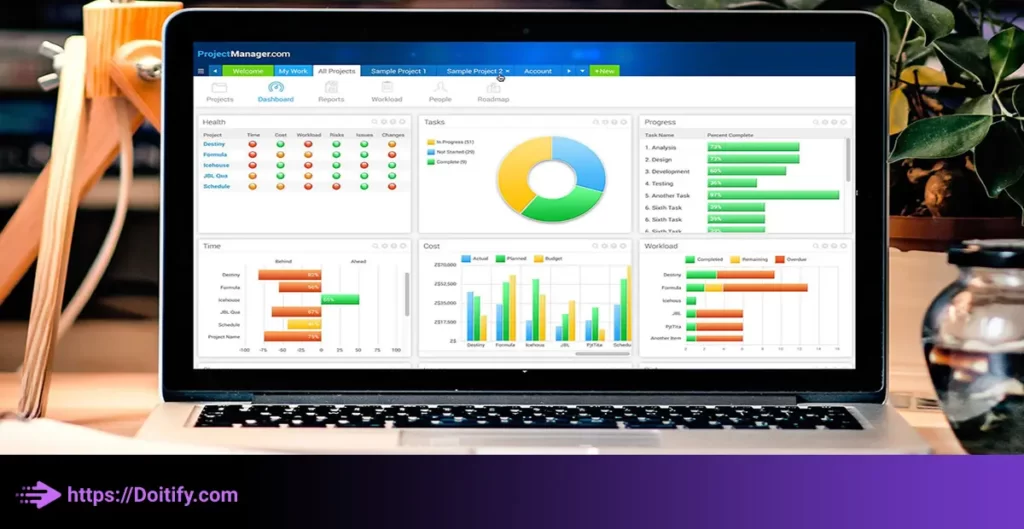Project management software benefits over Excel spreadsheets and simple to-do lists include the ability to scale to different types of projects and work groups. Automation of tasks without the need for manual data entry saves a lot of time and cost. However, not all project management software is built equally. Depending on your team size and needs, there are different options to consider and various methods to use them.
Table of Contents

Why Use A Project Management Tool?
Project management software benefits teams to plan, organize, and manage projects efficiently. It provides a centralized platform for project managers to collaborate with their teams, track progress, assign tasks, set deadlines, and monitor budgets.
The software can be used by teams of any size and across various industries to manage different types of projects, from software development to construction projects. It typically includes features such as task management, scheduling, resource allocation, budget tracking, and communication tools.
Some popular project management software includes Trello, Asana, Jira, Basecamp, Microsoft Project, and Smartsheet. These tools can be used on desktop and mobile devices, making it convenient for remote teams to collaborate and stay updated on project progress in real-time.
Selecting A Project Management Software With Benefits For The Business
Answering how and why use a project management tool based on needs can be challenging, as there are many options available on the market. Here are some factors to consider when selecting a project management tool:
- Features: Consider the features that are most important to you, such as task management, scheduling, resource allocation, budget tracking, and collaboration. Make a list of the features you need, and compare them with the features offered by different project management tools.
- Ease of Use: Look for a project management tool that is easy to use and has an intuitive interface. You want a tool that you can quickly learn and start using without a steep learning curve.
- Compatibility: Check the compatibility of the tool with your devices, operating system, and other software you use. Some project management tools have desktop and mobile apps, while others are cloud-based and accessible from any device with an internet connection.
- Pricing: Consider the pricing structure of the project management tool, including any subscription fees, add-ons, and support costs. Look for a tool that fits within your budget.
- Support: Look for a tool that offers adequate support, such as user guides, tutorials, and customer service. You want a tool that you can rely on if you encounter any issues.
- Reviews: Research user reviews and ratings for different project management tools to get a sense of their strengths and weaknesses. User reviews can provide valuable insights into the usability, reliability, and customer support of different tools.
Choosing the bestproject management tool for your needs depends on your specific requirements and preferences. Consider the factors mentioned above and evaluate different tools to find the one that best fits your needs. It can also be helpful to try out a few different tools with free trials or demos before making a final decision. By taking the time to research and compare different project management tools, you can find the one that will help you stay organized, productive, and successful in your projects.
We have been written about Time Tracking Project Management Tool in another article.

Benefits Of A Project Management Tool
Reason why use a project management tool includes:
Improved Organization
Project management software provides a centralized platform for project managers and their teams to organize and manage projects. By keeping all project-related information in one place, project management software can help to reduce confusion, prevent errors, and ensure that everyone is working towards the same goals.
Enhanced Collaboration
Project management software allows team members to collaborate more effectively, regardless of their physical location. By sharing information, assigning tasks, and communicating in real-time, team members can work together more efficiently and effectively.
Better Time Management
Project management software can help project managers to manage their time more effectively, by scheduling tasks, setting deadlines, and tracking progress. This can help to ensure that projects are completed on time and within budget.
Improved Resource Allocation
Project management software can help project managers to allocate resources, including people, time, and money, more efficiently. By assigning resources to specific tasks or phases of the project, project managers can ensure that resources are being used in the most effective way possible.
Better Risk Management
Project management software can help project managers to identify and manage risks more effectively. By tracking risks, developing contingency plans, and taking proactive measures to mitigate risks, project managers can reduce the likelihood of project delays or failures.
Increased Productivity
Project management software can help team members to be more productive by providing them with the tools they need to stay organized, collaborate effectively, and manage theirtime more efficiently. This can help to reduce stress, increase job satisfaction, and improve overall project outcomes.
Real-Time Progress Tracking
Project management software provides real-time updates on project progress, which allows project managers and team members to stay informed about project status at all times. This can help to identify and address issues quickly, avoiding delays and ensuring that projects are completed on time.
Better Reporting And Analysis
Project management software can generate a wide variety of reports to help project managers monitor progress, identify issues, and make informed decisions. By analyzing project data, project managers can identify areas for improvement, optimize resource allocation, and make data-driven decisions.
Remote Working
Modern projects are not bound by physical location or department, and remote working has become increasingly common. Remote project management software can help managers effectively lead and manage remote teams, making it easier to manage projects despite the distance and potential challenges of remote workforces.
Easier File Access And Sharing
Accessing and sharing important documents securely is crucial, and while shared drives have been a popular option for professionals, project management software is a more practical solution. Project management tools offer a centralized storage system where users can collaborate, make changes, leave feedback, and annotate documents easily. Additionally, these programs keep a change log to ensure transparency within the project team.
Project Management Software Benefits For Better Budget Tracking
Why use a project management tool for budget tracking:
- Budget Tracking Features: Many project management software come with built-in budget tracking features that allow you to set a budget for your project and track your spending against it. You can input your project budget and allocate funds to different tasks or phases of the project. The software can then keep track of your actual spending and show you how much money you have left.
- Resource Allocation: Project management software can help you allocate resources, including people, time, and money, to different tasks or phases of the project. By assigning resources in the software, you can see how much you are spending on each task, and whether you are over or under budget.
- Real-Time Updates: Project management software provides real-time updates on project status, which includes budget tracking. This means that you can see at a glance how much you have spent, how much you have left, and whether you are on track to meet your budget goals.
- Reporting: Many project management software come with reporting features that allow you to generate reports on project progress, including budget tracking. You can create reports that show how much you have spent, where you have spent it, and whether you are on track to meet your budget goals.

Examples Of Reports That Project Management Software Can Generate
examples of why use a Project management tool is because that it can generate a wide variety of reports to help project managers monitor progress and make informed decisions. Here are some examples of reports that project management software can generate:
- Gantt Charts: A Gantt chart is a visual representation of a project schedule that shows tasks, milestones, and dependencies over time. Project management software can generate Gantt charts to help project managers visualize the project schedule and identify critical path tasks.
- Resource Allocation Reports: Resource allocation reports show how resources, including people, time, and money, are being allocated across different tasks or phases of the project. These reports can help project managers identify resource bottlenecks and make adjustments to optimize resource allocation.
- Budget Reports: Budget reports show how much money has been allocated to different tasks or phases of the project and how much has been spent. These reports can help project managers identify areas where costs are exceeding the budget and make adjustments to stay on track.
- Task Status Reports: Task status reports show the status of individual tasks, including whether they are on track, behind schedule, or completed. These reports can help project managers identify tasks that are at risk of falling behind schedule and take corrective action.
- Risk Management Reports: Risk management reports identify potential risks to the project, including their likelihood and impact. These reports can help project managers develop risk mitigation strategies and contingency plans to minimize the impact of risks.
- Project Performance Reports: Project performance reports show how well the project is performing against key performance indicators(KPIs), such as schedule, budget, quality, and scope. These reports can help project managers assess the overall health of the project and identify areas for improvement.
- Time Tracking Reports: Time tracking reports show how much time team members are spending on different tasks or phases of the project. These reports can help project managers identify areas where team members may be over or under-utilized and adjust resource allocation accordingly.
- Communication Reports: Communication reports track communication among team members, stakeholders, and clients. These reports can help project managers ensure that communication is effective and timely, and identify areas where communication may need improvement.
Benefit Of Project Management Tool For Students
Project management software benefits for students, including:
Organization
Project management tools can help students to organize their tasks and assignments more effectively. By creating a to-do list and setting deadlines, students can prioritize their work and stay on track with their studies.
Collaboration
Many project management tools have collaboration features that allow students to work together on group projects. Students can share files, assign tasks, and communicate with each other in real-time, even if they are not in the same physical location.
Time Management
Project management tools can help students to manage their time more efficiently by breaking down larger assignments into smaller, more manageable tasks. By setting deadlines and tracking their progress, students can avoid procrastination and complete their work on time.
Productivity
Project management tools can increase students’ productivity by helping them to stay focused on their tasks and avoid distractions. Many tools have features that allow students to block distracting websites or apps during study sessions.
Accountability
Project management tools can help students to be more accountable for their work by tracking their progress and providing reminders of upcoming deadlines. This can help to reduce stress and anxiety and ensure that students are meeting their academic goals.
Benefit Of A Project Management Tool For Personal Use
Project management software benefits for personal and daily use, including:
Goal Setting
Project management tools can help individuals to set and achieve their personal goals. By breaking down larger goals into smaller, more manageable tasks, and setting deadlines, individuals can stay motivated and make progress towards their goals.
Task Management
Project management tools can help individuals to manage their daily tasks more efficiently. By organizing tasks in a to-do list, prioritizing them, and setting reminders, individuals can stay on track and avoid forgetting important tasks.
Time Management
Project management tools can help individuals to manage their time more effectively. By scheduling tasks and activities, individuals can ensure that they are making the most of their time and are not wasting it on unproductive activities.
Tracking Progress
Project management tools can help individuals to track their progress towards their goals. By monitoring their progress and making adjustments as needed, individuals can ensure that they are making steady progress towards their desired outcomes.
Collaboration
Project management tools can also be used for personal collaboration, such as planning a trip with friends or organizing a family event. By sharing information, assigning tasks, and communicating with each other in real-time, individuals can collaborate more effectively and ensure that everything runs smoothly.
Project Management Software Helps With Risk Management
Project management software benefits with risk management in several ways:
Risk Identification
Project management software can help with identifying potential risks by providing a central location for project managers and team members to document and categorize risks. This can include identifying potential risks related to project scope, budget, timeline, and quality.
Risk Assessment
Project management software can help with assessing the likelihood and impact of identified risks. Project managers can use the software to assign a probability and impact score to each risk, which can help them prioritize their risk management efforts.
Risk Mitigation
Project management software can help with developing and implementing risk mitigation strategies. Project managers can use the software to assign tasks, set deadlines, and track progress towards risk mitigation goals.
Risk Monitoring
Project management software can help with monitoring risks throughout the project lifecycle. Project managers can use the software to track the status of each risk, including whether it has been mitigated or is still a potential threat.
Risk Reporting
Project management software can help with reporting on project risks. Project managers can use the software to generate risk reports, which can help them communicate risk status to project stakeholders and make data-driven decisions.
Collaboration
Project management software can help with collaboration between project team members when it comes to risk management. Team members can share information, collaborate on risk mitigation strategies, and monitor risk status in real-time, even if they are not in the same physical location.
Project Management Software Helps With Risk Mitigation
Project management software benefits with risk mitigation in several ways:
Task Management
Project management software can help with assigning tasks related to risk mitigation to team members and tracking progress. By breaking down risk mitigation strategies into smaller, more manageable tasks, project managers can ensure that they are being addressed in a timely and effective manner.
Resource Allocation
Project management software can help with allocating resources, including people, time, and money, to risk mitigation efforts. By assigning resources to specific tasks or phases of the project, project managers can ensure that they are being used in the most effective way possible.
Scheduling
Project management software can help with scheduling risk mitigation activities to ensure that they are completed on time. By setting deadlines and tracking progress, project managers can ensure that risk mitigation efforts are on track and that potential risks are being addressed in a timely manner.
Collaboration
Project management software can help with collaboration between project team members when it comes to risk mitigation. Team members can share information, collaborate on risk mitigation strategies, and monitor risk status in real-time, even if they are not in the same physical location.
Reporting
Project management software can help with reporting on risk mitigation efforts. Project managers can use the software to generate reports on risk mitigation progress, which can help them communicate risk status to project stakeholders and make data-driven decisions.
Real-Time Progress Tracking
Project management software provides real-time updates on project progress, which allows project managers and team members to stayinformed about risk mitigation progress at all times. This can help to identify and address issues quickly, avoiding delays and ensuring that risks are being managed effectively.
Risk Analysis
Project management software can help with analyzing project data to identify potential risks and their root causes. By analyzing project data, project managers can uncover patterns and trends that may be contributing to risks and take proactive measures to mitigate them.
Conclusion
While project management software benefits over manual methods, not all tools are equally suitable for every team. Choosing software that matches your specific needs in terms of features, ease of use, team size and budget is critical to maximizing its benefits. A combination of software, spreadsheets and to-do lists based on the strengths of each can also be effective. The key is to find an approach that works best for managing your projects efficiently.
FAQs
Why use a project management tool?
Project management software benefits teams by enabling them to plan, organize and manage projects efficiently. It provides a centralized platform to collaborate, track progress, assign tasks, set deadlines and monitor budgets. Automating manual tasks saves time and costs.
What are project management software benefits?
Benefits include improved organization, collaboration, time management, resource allocation, productivity, risk management and data-driven decision making through reports and dashboards.
How does project management software benefits with budget tracking?
It offers budget tracking features to set and allocate budgets to tasks, provides real-time updates on spending, and generates reports to keep teams on budget.
What reports can project management software generate?
It can generate Gantt charts, resource allocation reports, budget reports, task status reports, risk management reports, time tracking reports and more.
How does it help with risk management and mitigation?
It helps with risk identification, assessment, mitigation through features like task management, scheduling, collaboration and reporting. Risk analysis of project data also helps uncover root causes of risks.



